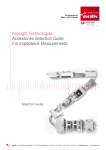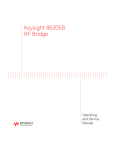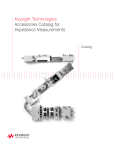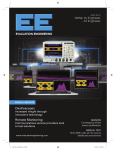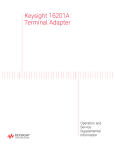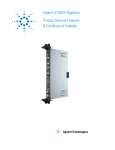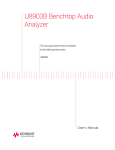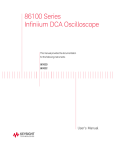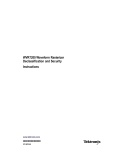Download Product Declassification and Security
Transcript
®
E stablished 1981
Advanced Test Equipment Rentals
www.atecorp.com 800-404-ATEC (2832)
E5061B Security Feature
Rev. 3.0
E5061-90900
Jun 2012
Copyright 2010-2012 Agilent Technologies
Page 1 of 11
Contacting Agilent Sales and Service Offices
Assistance with test and measurements needs and information on finding local Agilent offices
are available on the internet at, http://www.agilent.com/find/assist. If you do not have access to
the internet, please contact your field engineer.
Note: In any correspondence or telephone conversations, refer to the signal generator by its
model number and full serial number. With this information, the Agilent representative can
determine whether your unit is still within its warranty period.
Page 2 of 11
Product Declassification and Security
Product Name: Network Analyzer
Model Number(s): E5061B
Product Declassification and Security
Model Number(s): E5061B
Product Name: Network Analyzer
Product Family Name: ENA-LF
This document describes instrument security features and the steps to declassify an instrument
through memory sanitization or removal.
Table of Contents
Terms and Definitions. …………………………………………….......4
Instrument Memory……………………………………………….....…5
Memory Clearing, Sanitization and/or Removal………………….....…6
User and Remote Interface Security ………...……………….…..……10
Page 3 of 11
Product Declassification and Security
Product Name: Network Analyzer
Model Number(s): E5061B
Terms and Definitions
Definitions:
Clearing – Clearing is the process of eradicating the data on media before reusing the media so that the data can
no longer be retrieved using the standard interfaces on the instrument. Clearing is typically used when the
instrument is to remain in an environment with an acceptable level of protection.
Sanitization – Sanitization is the process of removing or eradicating stored data so that the data cannot be
recovered using any known technology. Instrument sanitization is typically required when an instrument is moved
from a secure to a non-secure environment such as when it is returned to the factory for calibration. Agilent memory
sanitization procedures are designed for customers who need to meet the requirements specified by the US Defense
Security Service (DSS). These requirements are outlined in the “Clearing and Sanitization Matrix” issued by the
Cognizant Security Agency (CSA) and referenced in National Industrial Security Program Operating Manual
(NISPOM) DoD 5220.22M ISL 01L-1 section 8-301.
Security erase – Security erase is a term that is used to refer to either the clearing or sanitization features of
Agilent instruments.
Instrument declassification – A term that refers to procedures that must be undertaken before an instrument
can be removed from a secure environment such as is the case when the instrument is returned for calibration.
Declassification procedures will include memory sanitization and/or memory removal. Agilent declassification
procedures are designed to meet the requirements specified by the DSS NISPOM security document (DoD
5220.22M chapter 8)
Page 4 of 11
Product Declassification and Security
Product Name: Network Analyzer
Model Number(s): E5061B
Instrument Memory
This section contains information on the types of memory available in your instrument. It explains the size of
memory, how it is used, its location, volatility, and the sanitization procedure.
Writable During
Normal Operation?
Data Retained When
Powered Off?
Summary of instrument memory - base instrument
Main
Memory
(DRAM)
2GB
Media
Storage
(Hard Disk
Drive)
160 GB
Yes
No
Windows Operating
system memory
Operating
system (not
user defined)
A50/A60 CPU
Module
Yes
Yes
Windows Operating
system boot device,
factory correction
data, and users file
including saved
traces data, settings,
or images.
User-Saved
Data
HDD assembly
Remove
Memory for
DSP module
(RAM)
1.8M bit
Yes
Yes
Data Processing for
measurement
Measurement
(not user
defined)
A51 DSP Module
Cycle power
Non-volatile
Memory
(Flash)
512M Bit
No
Yes
N/A
(The data is
not stored by
user under
normal
operation.)
No
Yes
Adjustment
Program
performed by
Agilent factory
personnel or by
calibration
labs
Calibration at
factory
A51 DSP Module
Non-volatile
Memory
(EEPROM)
256M Bit
Product serial
number, Options,
System calibration
(correction
constants) data
(not user defined
calibration data)
Module serial
number, Revision
number
A1 /A11 Source
Module
N/A
(The data is
not stored by
user under
normal
operation.)
Memory
Type and
Size
Purpose/Contents
Data Input
Method
Location in
Instrument and
Remarks
Sanitization
Procedure
Cycle power
Operating
system (not
user defined)
A2 Receiver Module
(Opt. 3L5)
A3 Receiver Module
(Opt. xx5, 50 ohm)
A4 Receiver Module
(Opt. xx7, 75 ohm)
A9 LF Source/Bias
Module (Opt. 3L5)
Page 5 of 11
Product Declassification and Security
Product Name: Network Analyzer
Model Number(s): E5061B
Memory Clearing, Sanitization and/or Removal Procedures
This section explains how to clear, sanitize, and remove memory from your instrument for all memory types.
<Memory type>
Description and
purpose
Size
Memory clearing
Memory sanitization
Memory removal
Write protecting
Memory validation
Remarks
Main Memory for Windows Operating system memory
Description and
purpose
Size
Media Storage (Hard Disk Drive)
Memory clearing
Memory sanitization
Memory removal
N/A
N/A
The hard disk drive needs to be removed and replaced with a new or unused hard
disk drive part as per the service manual. See E5061B Service Manual for more
detail information on the procedure as well as the replacement parts.
N/A
N/A
Write protecting
Memory validation
Remarks
2 GB
Power rebooting. This is a volatile memory.
Power rebooting. This is a volatile memory.
This memory cannot be removed without damaging the instrument
N/A
N/A
160 GB
Description and
purpose
Size
Memory clearing
Memory sanitization
Memory removal
Write protecting
Memory validation
Remarks
Memory for DSP (RAM) for A51 DSP Module
Description and
purpose
Non-volatile memory (Flash) for A51 DSP Module. This memory is for product
serial number, option and system calibration data (Any user data is not stored in
these memory)
512M Bit
N/A
N/A
The A51 DSM module needs to be removed and replaced with a new or unused
module as per the service manual. See E5061B Service Manual for more detail
information on the procedure as well as the replacement parts.
N/A
N/A
Size
Memory clearing
Memory sanitization
Memory removal
Write protecting
Memory validation
Remarks
1.8M bit
Power rebooting. This is a volatile memory.
Power rebooting. This is a volatile memory.
This memory cannot be removed without damaging the instrument.
N/A
N/A
Page 6 of 11
Product Declassification and Security
Description and
purpose
Size
Memory clearing
Memory sanitization
Memory removal
Write protecting
Memory validation
Remarks
Product Name: Network Analyzer
Model Number(s): E5061B
Non-volatile memory (EEPROM) for A1, A2, A3, A4, A9 and A11 Modules.
These memories are for board serial number, board revision number. (Any user
data is not stored in these memories)
256 M Bit
N/A
N/A
The A1, A2, A3, A4, A9 and A11 modules need to be removed and replaced with
a new or unused module as per the service manual. See E5061B Service Manual
for more detail information on the procedure as well as the replacement parts.
N/A
N/A
Hard Disk removal (Option 020 only)
Because it is virtually impossible to completely and selectively erase all user data on a hard drive
without also destroying the operating system, the best method for maintaining security when the
E5061B must be removed from a secure area is to replace the hard drive with a "non-secure"
hard drive, i.e. a drive that has never had any sensitive data placed on it. This allows the E5061B
to still function properly in non-secured areas or for use when servicing.
The E5061B-020 has a removable hard drive on the rear panel. Agilent has available a preconfigured hard drive for the E5061B that must be purchased in order for this security method to
work. A spare disk is available as below.
Windows License (See the Windows label on the rear panel) Agilent Part Number
Windows Vista Business
E5061-82201
Windows XP Pro for Embedded Systems
E5061-82202
Note: The limited number of times for removing/connecting is 50 times.
Hard disk removal procedure:
These steps should be followed to maintain security:
1. Clearly mark the spare hard drive as "Unsecured!"
2. If there is the file named gen.lic under E:\License directory, copy it into your USB memory.
This file contains software option information.
3. Remove the two screws on the rear panel. Remove the case with the hard drive and put it on
the top panel. (It is recommended to place a cushion on the top panel to put the hard drive.)
Page 7 of 11
Product Declassification and Security
Product Name: Network Analyzer
Model Number(s): E5061B
4. Disconnect both connectors from the HDD, and then remove the four screws holding the hard
drive to the case.
5. Replace the original “Secured” hard drive with the spare "Unsecured" hard drive.
6. Connect an external keyboard and mouse to the connectors on the E5061B. Turn on the
E5061B.
7. Press [Macro Setup] and press Load Project... in the softkey menu.
8. A dialog box will appear for you to select the program to load. Select RestoreSysCorFile.vba
from the D:\Agilent\Service folder and then press the Open button.
9. Press [Macro Run]. The RestoreSysCorFile dialog box will appear. Click OK.
10. Place the gen.lic files into the E:\License directory. Manually create the License directory if
the directory does not exist.
The E5061B can now be used elsewhere or sent for servicing without fear of leaking any
sensitive information.
Hard disk re-installation procedure:
Once the E5061B is returned to the secured area, follow the steps listed below. Any servicing of
the E5061B may include the regeneration of correction constants.
1. Remove the spare “Unsecured” hard drive and replace with the original “Secured” hard drive
2. Connect the external keyboard and mouse to the connectors on the E5061B. Turn on the
E5061B.
Page 8 of 11
Product Declassification and Security
Product Name: Network Analyzer
Model Number(s): E5061B
3. Press [Macro Setup] and press Load Project... in the softkey menu.
4. A dialog box will appear for you to select the program to load. Select RestoreSysCorFile.vba
from the D:\Agilent\Service folder and then press the Open button.
5. Press [Macro Run]. The RestoreSysCorFile dialog box will appear. Click OK.
6. Copy the gen.lic files from your USB memory into the E:\License directory. Manually create
the License directory if the directory does not exist.
Note: If your secured hard disk does not contain the “RestoreSysCorFile.vba” program, copy the
program from the unsecured hard disk.
Page 9 of 11
Product Declassification and Security
Product Name: Network Analyzer
Model Number(s): E5061B
User and Remote Interface Security Measures
Screen and Annotation Blanking
The frequency-blanking feature is available. This function provides three security levels:
“OFF” during normal operation;
“Low” deletes frequency information from the display, but can be turned “OFF” by front panel operation;
and
“High” deletes frequency information from the display, and cannot be turned “OFF” except rebooting.
The operator can perform the following keystrokes to control this frequency-blanking feature, [System] >
Service Menu > Security Level > None | Low | High,
or set the levels by the following SCPI command:
:SYSTem:SECurity:LEVel {NONE|LOW|HIGH}
Note:
Any SCPI/COM commands that read the frequency data are not influenced by this function. All commands
can read frequency data regardless of the security level.
USB Mass Storage Device Security
Users can disable any USB-compatible external mass storage devices in order to ensure confidentiality.
The following procedure shows how to disable a USB Mass Storage Device.
1.
2.
3.
[Save/Recall] > Explorer….
Double-click “DisableUsbStorage.exe” from D”\Agilent\Service.
Click OK in the SUCCEEDED message window that appears. If any USB mass storage device is
connected to the E4982A under this condition, the Hardware Wizard will start, but the USB mass
storage device will not work.
The following procedure shows how to enable a USB Mass Storage Device.
1.
2.
3.
[Save/Recall] > Explorer….
Double-click “EnableUsbStorage.exe” from D”\Agilent\Service.
Click OK in the SUCCEEDED message window that appears.
Note: If you do not want any USB mass storage device to ever be enabled at any time, delete
EnableUsbStorage.exe from the E4982A after DisableUsbStorage.exe has been completed. These two
programs will not be recovered automatically by applying the firmware update or other such action. Before
deleting any of these programs, you should make a backup copy to a recording medium such as a floppy
disk and store it separately.
Note: If the program fails to run, it is possible that you have not logged in as a user in the Administrators
Group. When you want to execute any of the above programs, make sure to log in as a user in the
Administrators Group.
Remote Access Interfaces
The user is responsible for providing security for the I/O ports for remote access by controlling physical
access to the I/O ports. The I/O ports must be controlled because they provide access to all user settings,
user states and the display image.
The I/O ports include USB, GPIB and LAN.
The LAN port provides the following services, which can be selectively disabled:
a) http
Page 10 of 11
Product Declassification and Security
Product Name: Network Analyzer
Model Number(s): E5061B
b) ftp
c) sockets
d) telnet
There is also a „ping‟ service, which presently cannot be selectively disabled. The concern might be that it
is possible to discover IP addresses of connected instruments in order to query their setups over the net or
break into the code.
Page 11 of 11












